

All Saints
|
|
|
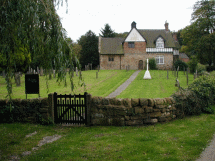 |
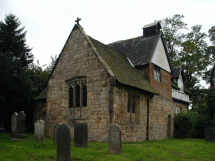 |
| 1 |
2 |
|
Dale
Abbey |
| |
This tiny church,
or perhaps more properly, chapel, measures some 25ft by 26 ft, and is just
larger than Stockwood in Dorset and Culbone in Somerset in that it has an aisle
as well as a nave.
It is attached to
another building, a gabled Tudor house, as seen in the above two pictures (1
& 2). This house was once the Infirmary of Dale Abbey, together with its
attached chapel. Following the Dissolution the infirmary eventually became the
Blue Bell Inn, then a farmhouse, and now it is just a private house, the land
and buildings having been sold away.
When an Inn, it
is believed taht the clergy used to dress in the Bar, and entered the chapel
through a now blocked doorway. Before that, in the time of the Abbey, when the
sick attended service they would enter the chapel using the outside staircase
(3), and thence into the upper gallery.
|
|
|
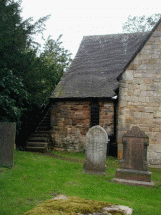 |
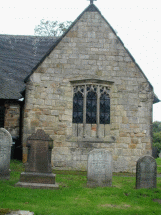 |
| 3 |
4 |
| |
The two pictures
above (3 & 4) show the outside staircase and east end.
Internally there
are two chambers, loosely described as the nave and the aisle, possibly
originally separated by a solid wall to demarcate the canons' oratory and the
parish church or nave. The late 15th century saw the church being reordered,
and the wall was replaced by a wooden screen with a gallery over.
|
|
|
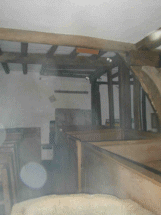 |
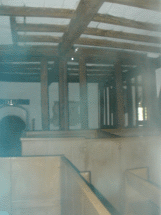 |
| 5 |
6 |
| |
These internal
pictures were taken through very dirty windows, because there was nobody around
to let us in, but show the aisle with the underside of the gallery. The nave
itself has three pew benches and a small harmonium, the pulpit is in the far
corner, behind the clerk's desk, which in turn is behind the small table which
serves as the altar. As well as all this, there is a large chair, originally
procured by Lord Stanhope as his bishop's 'throne', a box-pew and other beams,
pews and screens. .
|
|
|
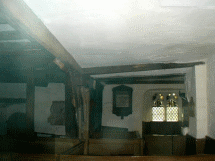 |
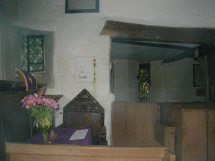 |
| 7 |
8 |
| |
In picture 7, the
front of the pulpit can just be discerned to the right of the window, under
which is the harmonium. Picture 8 shows the altar table with the clerk's desk
to the left, and below, picture 9 is the view from the clerk's desk, taken
through the window behind it. Under enlarged magnification you can read the
lectionary which is laid open on the desk top.
|
|
|
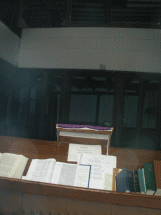 |
9
|
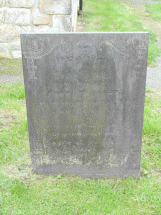 |
10
|
| |
In the graveyard
there is a series of tombstones cut by a local mason, which use the local
stone, and are cut vigorously with a local flavour all to themselves. Pictures
10 and 11 show the detail of one of them, including a serpent piercing a
skull.
|
|
|
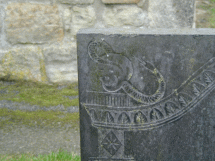 |
| 11 |
|
| |
The Legend of
Dale Abbey
"History" would
have it that in the 12th century a baker saw a vision in which he was told to
leave his work and his home and become a hermit in Depedale. Having done so a
knight took pity on him and paid for the building of a chapel. Further, a
woman, known as the 'Gome of the Dale', subsequently took pity on him, extended
the chapel and persuaded her nephew to found an abbey nearby.
Nothing remains
of this Abbey, apart from a few ruins down the hillside, and all that remains
are the old Infirmary and Chapel. |
|
|
|
ACCESS |
Map reference :
It is
approached down the main street of the village, to the dead-end at the bottom,
round the corner out of sight. The chapel is kept locked, and at the time of
our visit no-one could be found who had a key.
|
|
Photographs © 2001
Edwin Macadam and Sheila Girling
Smith
|
|
Please see our
Home Page
for important
copyright notice
|
 |
|

|
|
|

|
|
|
|
|
SEARCH THIS SITE |
|
|
This
site has been constructed by, and remains the copyright of,
its authors,
Edwin and Sheila Macadam,
Shelwin, 30, Eynsham Road, Botley,
Oxford OX2 9BP
|
|
| ©
July 2001 -
|
|












